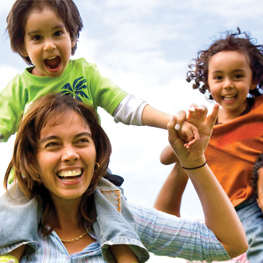
Moms and dads often feel the need to return to work when children are still very young. It can be hard for parents to leave toddlers or even preschoolers with another caregiver. How can we trust another person to know what is best for our kids when we’re away? Starting when they are preschoolers - and even earlier - parents can begin to teach their children to recognize inappropriate behavior and respond if they need help. Education is the key to prevention. Educating them about boundaries and healthy relationships early can support their positive experience with an alternate caregiver. Every child has a right to be safe.
Where to start?
It can help to introduce young children to concepts of healthy and unhealthy relationships.
From the moment children are born, they witness relationships between family members, acquaintances, strangers, and friends. Healthy development depends on healthy interactions, and healthy relationships are built on a foundation of respect and trust. They provide safety, equality, and nurturing communication.
Understanding healthy relationships makes it easier to recognize when they are unhealthy. Adults have power over children. We can use our power to support healthy relationships or to cause harm. The misuse of power is a common element in bullying behavior and many types of abuse. By talking openly with our children about their experiences with others, we can become aware of and support them in addressing unhealthy relationships or abuses of power.
Beyond understanding healthy and unhealthy relationships, there are many ways parents can help young children be safe outside the home. Here are some ways:
Inform. Talk to your child about their rights when they are old enough to understand them. Our children’s right to have their basic needs met and be in a safe environment, protected from abuse, is enshrined in the United Nations Convention on the Rights of the Child.
Support healthy boundaries. Help children develop an age-appropriate understanding of body ownership. Develop boundaries and support mutual respect around privacy. Teach children the difference between safe and unsafe touching: “My body is mine.”
Keep good secrets. There is a difference between good and bad secrets. Children should know the difference, and learn that telling is important if someone asks them to keep a bad secret.
Say No! Go! Tell! Teach these simple personal safety rules for young children. Tell them to say “no,” leave, and tell a safe person if someone asks them to do something they are uncomfortable with or know is wrong.
Discuss safe people. Make sure children learn early on who would be an appropriate safe person to go to for help in any situation they might be in while you’re away.
Accept difference. Conflict and arguing between children is normal and developmentally appropriate, a product of the fact that we all see the world differently. Teach children to value and accept difference, and that conflicts can be resolved quickly and amicably, allowing the two to remain friends. But if your child is in an unhealthy relationship with a friend, they may need support to set new boundaries or create distance from that friend.
Keep technology in its place. Screen time often replaces exploration, imaginative play, outdoor activity, and interaction. The Canadian Paediatric Society recommends limiting television watching to less than one to two hours per day for older children (over the age of two).
Monitor children’s time online to ensure they do not become exposed to cyber-bullying or online predators.
Watch for violence and abuse. Violence has no boundaries. It can affect anyone, but the smallest, weakest members of society, children, are the most vulnerable. There are a variety of types of violence that can have lasting and harmful effects on children, including emotional abuse, physical abuse, physical punishment, neglect, and sexual violence.
Address possible abuse early. If you suspect your child is experiencing abuse, trust your instincts. Say to your child: “I am worried about you; you seem upset. Is something wrong? I want to help.”
Be prepared to listen and help. Don’t promise to be part of the secret. Don’t interview; just confirm if they have been harmed and need help. Let them know you are happy they told you, and that you will get help. If there has been abuse, report it.
Get support. Join parent or play groups, book clubs or library groups, or take a parenting class. It’s a way to share experiences, get ideas, learn about your child’s developmental norms, and meet other parents. Ask for help from a community health nurse, faith program, or community service.
Discipline your child and yourself. Set fair rules and apply them consistently. Teach, listen, problem-solve, and set a good example. Manage your child’s behavior in a positive, learning way.
Finally, be patient. Developing trust in another caregiver to provide the best for our child takes time. Getting to know them better along with your child
will help.
To learn more about the Red Cross Be Safe Program, visit redcross.ca/besafe or email This email address is being protected from spambots. You need JavaScript enabled to view it.a.
Calgary’s Child Magazine © 2024 Calgary’s Child